An illustrated reconstruction of the Bronze Age stilt settlement unearthed at Must Farm in the East of England. Credit: Cambridge Archaeological Unit
A major report on the remains of a stilt village that was engulfed in flames almost 3,000 years ago reveals in unprecedented detail the daily lives of England’s prehistoric fenlanders.
Must Farm, a late Bronze Age settlement, dates to around 850 BC, with University of Cambridge archaeologists unearthing four large wooden roundhouses and a square entranceway structure – all of which had been constructed on stilts above a slow-moving river.
The entire hamlet stood approximately two meters above the riverbed, with walkways bridging some of the main houses, and was surrounded by a two-meter-high fence of sharpened posts.
The settlement was less than a year old when it was destroyed by a catastrophic fire, with buildings and their contents collapsing into the muddy river below. The combination of charring and waterlogging led to exceptional preservation. The site has been described as “Britain’s Pompeii.”
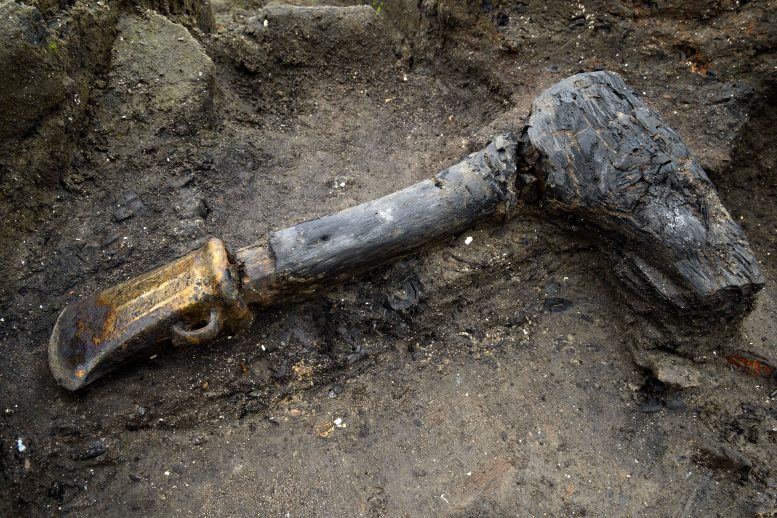
An intact hafted axe that had been placed in the silt directly beneath Structure One, perhaps a token of good fortune, or an offering to some kind of spirit on completion of the build. Credit: Cambridge Archaeological Unit
Years of research conducted on thousands of artifacts from the site have now shown that early Fen folk had surprisingly comfortable lifestyles, with domestic layouts similar to modern homes, meals of “honey-glazed venison”, clothes of fine flax linen, and even a recycling bin.
The settlement-on-stilts also contained a stack of spears with shafts over three meters long, as well as a necklace with beads from as far away as Denmark and Iran, and a human skull rendered smooth by touch, perhaps a memento of a lost loved one.
The Cambridge archaeologists say the site provides a unique “blueprint” for the circular architecture, home interiors, and overall domesticity of those who inhabited the swampy fenland of East Anglia some eight centuries before Romans set foot on British shores.
Full findings from the Must Farm site – excavated by the Cambridge Archaeological Unit (CAU) in 2015-16 after its discovery on the edge of Whittlesey near Peterborough – are published in two reports, both made available by Cambridge’s McDonald Institute for Archaeological Research.
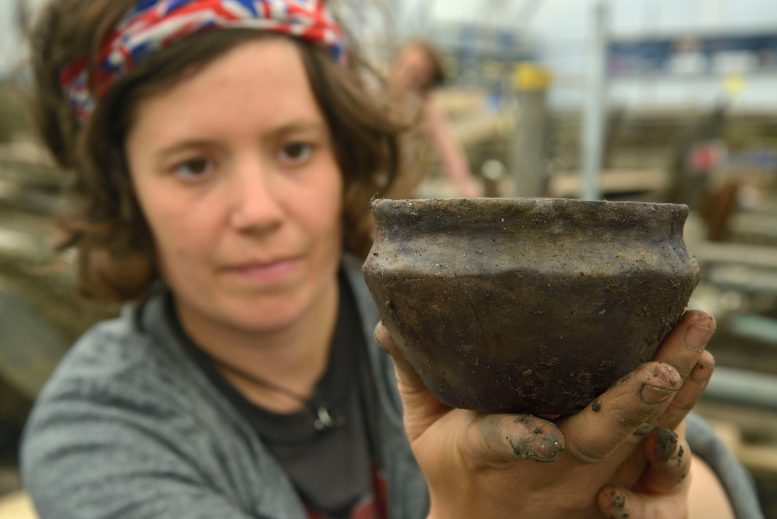
A member of the Cambridge Archaeological Unit on-site at the Must Farm excavation in 2016 displays a pot recovered from the ‘kitchen area’ of one of the roundhouses. Credit: Cambridge Archaeological Unit
“These people were confident and accomplished home-builders. They had a design that worked beautifully for an increasingly drowned landscape,” said CAU’s Mark Knight, report co-author and excavation director.
“While excavating the site there was a sense that its Bronze Age residents had only just left. You could almost see and smell their world, from the glint of metal tools hanging on wattled walls to the sharp milkiness of brewed porridge.”
‘Mirror’ of ancient home interiors
The ruins of five structures were uncovered, along with walkways and fencing, but the original settlement was likely twice as big – half the site was removed by 20th-century quarrying – with researchers saying it may have held up to sixty occupants in family units.
The river running underneath the community would have been shallow, sluggish, and thick with vegetation. This cushioned the scorched remains where they fell, creating an archaeological “mirror” of what had stood above – allowing researchers to map the layout of the structures.
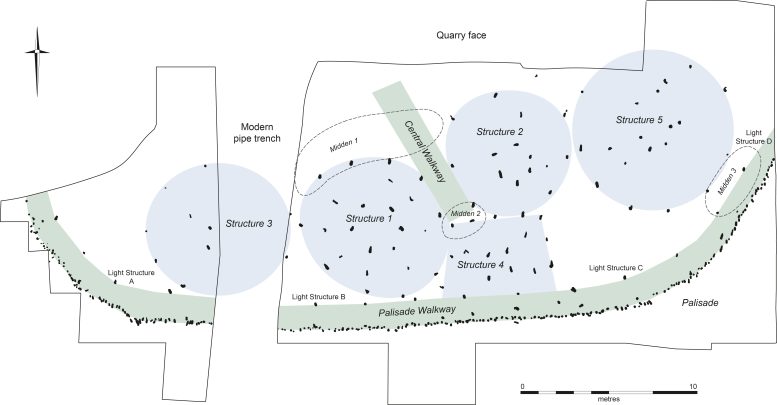
An overview site plan of the Bronze Age settlement unearthed at Must Farm in the East of England. Credit: Cambridge Archaeological Unit
One of the main roundhouses, with almost fifty square meters of floor space, appeared to have distinct activity zones comparable to rooms in a modern home.
“Conducting research on Must Farm is a bit like getting an estate agent’s tour of a Bronze Age stilt house,” said David Gibson, report co-author and Archaeological Manager at CAU.
Ceramic and wooden containers, including tiny cups, bowls, and large storage jars, were found in the northeast quadrant of “Structure One”, the location of a kitchen. Some pots were even nested: designed to stack inside one another to save space.
Metal tools were stored along the building’s eastern side, while the empty northwest area was probably reserved for sleeping. The southeast space had lots of cloth fragments, along with bobbins and loom weights. This was close to a likely entrance, where extra light would have helped with textile work.
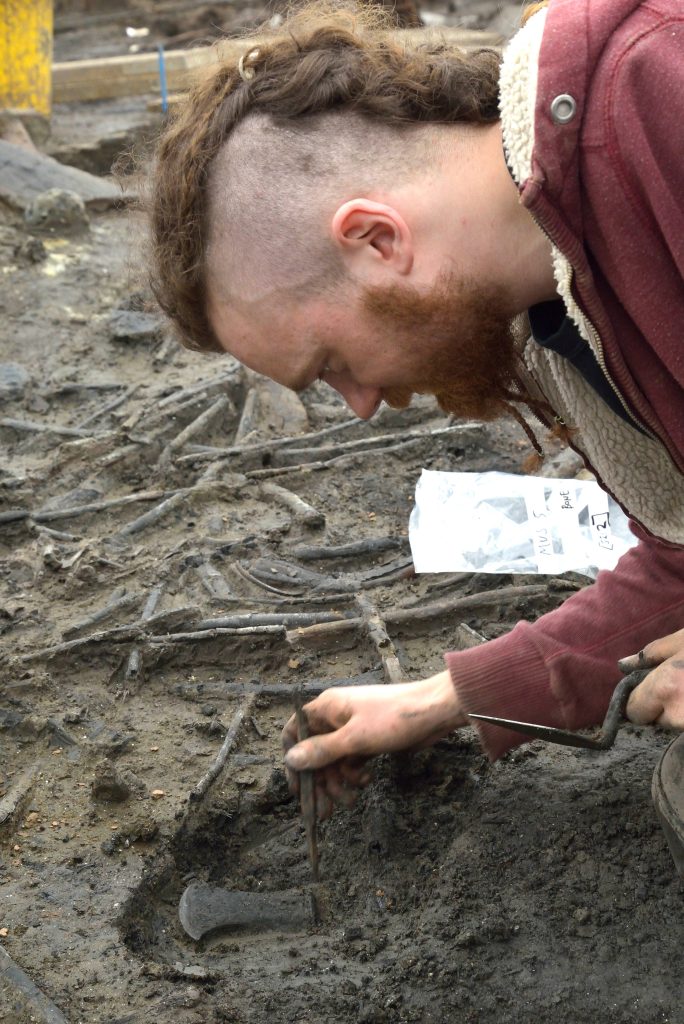
A member of the Cambridge Archaeological Unit uncovering an axe head during excavations at the Must Farm site in 2016. Credit: Cambridge Archaeological Unit
The roundhouse’s southwest quadrant was reserved for keeping lambs indoors. There was no evidence of humans dying in the fire, but several young sheep had been trapped and burnt alive.
Skeletal remains showed the lambs were three to six months old, suggesting the settlement was destroyed sometime in late summer or early autumn. Evidence that the wooden architecture was still “green” confirms construction took place around nine months to a year earlier.
Tool kits, textiles, and a token of good luck
Household inventories were remarkably consistent. All the roundhouses contained a metalwork “tool kit” that included sickles (crop-harvesting blades) along with axes and curved “gouges” used to hack and chisel wood, as well as hand-held razors for cutting hair.
Most buildings had objects for making textiles, from spindle whorls to thread bobbins, although the distribution suggests that “spinning” – the process of twisting fibers together – was conducted in three of the roundhouses, but Structure One was where this yarn got converted to fabrics.
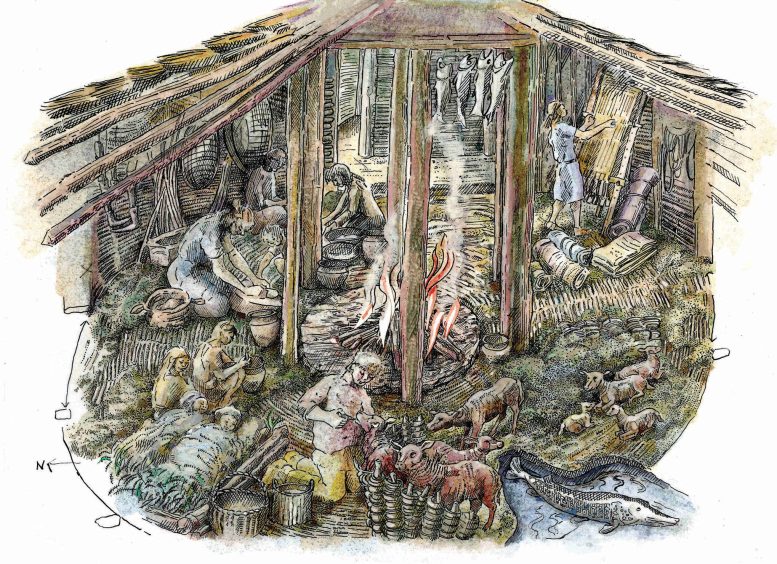
An illustration depicting daily life inside ‘Structure One’, based on the analysis of materials unearthed at the Must Farm excavation. Credit: Judith Dobie/Historic England
The textiles are the finest of this period found in Europe, with details such as “pile tufts” that would have given garments a soft, almost velvety feel, and “tubular selvage” for neat seams and hems.
Each roundhouse roof had three layers: insulating straw topped by turf and completed with clay – making them warm and waterproof but still well-ventilated. “In a freezing winter, with winds cutting across the Fens, these roundhouses would have been pretty cozy,” said CAU project archaeologist Dr Chris Wakefield.
Structure Four, a smaller square building, may also have acted as the settlement’s entrance. A large wooden bucket had been kept within, containing several damaged bronze objects and worn axe heads, waiting to be smelted down and recycled into new tools.
Encircling the footprint of each roundhouse were “middens”, haloes of rubbish dumped from the stilt village above, including broken pots, butchered animal bone, and “coprolites” or fossilized faeces. Some human coprolites had parasite eggs, suggesting inhabitants struggled with intestinal worms.
One item, however, had been placed in the silt directly beneath Structure One: an intact hafted axe, perhaps a token of good fortune, or an offering to some kind of spirit on completion of the build.
‘Meaty porridge’
Despite millennia in the mud, many artifacts still bore traces of daily life – along with its sudden interruption as inhabitants abandoned their possessions to escape the blaze.
For example, a pottery bowl with the finger marks of its maker captured in the clay was found still holding its final meal: a wheat-grain porridge mixed with animal fats (possibly goat or red deer). The wooden spatula used for stirring was resting against the inside of the bowl.
“It appears the occupants saved their meat juices to use as toppings for porridge,” said Dr Chris Wakefield. “The site is providing us with hints of recipes for Bronze Age breakfasts and roast dinners.”
“Chemical analyses of the bowls and jars showed traces of honey along with ruminant meats such as deer, suggesting these ingredients were combined to create a form of prehistoric honey-glazed venison.”
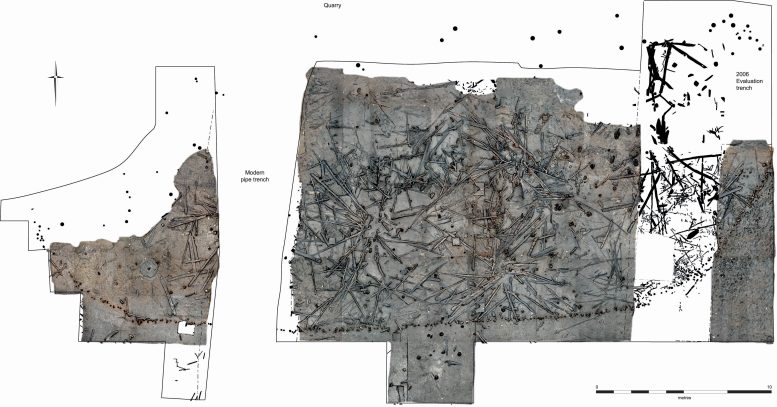
A photogrammetry visualization of the Bronze Age settlement excavated at Must Farm. Credit: Cambridge Archaeological Unit
The stilt-house dwellers even had favorite cuts of meat, often only bringing the forelegs of a boar back for roasting, for example. Preferred aquatic dishes included pike and bream.
Several small dog skulls suggest the animals were kept domestically, perhaps as pets but also to help flush out prey on a hunt. Dog coprolites show they fed on scraps from their owners’ meals.
Must Farm’s residents used the local woodlands – evidence suggests within a two-mile radius – to hunt boar and deer, graze sheep, and harvest crops such as wheat and flax as well as wood for construction. Waterways were vital for transporting all these materials.
The remains of nine log-boats, canoes hollowed from old tree trunks, were found upstream, dating from across the Bronze and into the Iron Age, included some that were contemporary to Must Farm.
“Boat journeys through reed swamps to the woodlands would have been made many times during the site’s short life,” said Wakefield. “In summer, that meant traversing clouds of mosquitos.”
Much of what was retrieved from Must Farm were everyday items, the Bronze Age equivalent to the TV remotes and coffee mugs of our own lives. However, some items would have been precious.
A necklace of beads made from glass, amber, siltstone, and shale had been lost in the fire. In fact, decorative beads were found right across the site. All but one of Must Farm’s 49 glass beads came from far-flung places, including Northern and Eastern Europe, and even the Middle East.
“Such items would gradually make their way across thousands of miles in a long series of small trades,” said Wakefield.
Up in flames…
The researchers say that, while the Bronze Age could be violent, and aspects of the site’s structure are clearly defensive, its location may be as much to do with resources. Spears found on site, up to 3.4 meters in length, as well as swords, were as likely to be used in animal hunts as on rival groups.
A few human remains were recovered, including the skull of an adult woman polished by repeated touch – a sign this may have been a keepsake of love rather than war.
“The cause of the fire that tore through the settlement will probably never be known,” said CAU’s David Gibson. “Some argue it may have come under attack, as the occupants never returned for their goods, which would have been fairly easy to retrieve from the shallow waters”.
However, others think it is more likely to have been an accident. If an internal fire took hold in one of the roundhouses, it would spread between the tightknit structures within minutes.
Added Gibson: “A settlement like this would have had a shelf-life of maybe a generation, and the people who built it had clearly constructed similar sites before. It may be that after the fire, they simply started again.”
“There is every possibility that the remains of many more of these stilted settlements are buried across Fenland, waiting for us to find them.”
The major £1.1 million excavation project was funded by Historic England and building supplier Forterra. It was carried out by Cambridge Archaeological Unit of the University of Cambridge. The remains were removed for recording and analysis due to concerns about the location and future preservation of the site.





